Optimise for Surprise
Understanding the ‘surprise sequence’—Freeze, Find, Shift, Share—can boost your content's social media performance by revealing how to increase share-time.
Social media is a hunt for novelty. But why are we do we feel so compelled to like and share our finds? It turns out, we share or we die.
The thrill of discovery is fueled by dopamine, a neurotransmitter that activates when we're pleasantly surprised but not when we're merely satisfied. Evolutionary biologists have theorised that this is why we're driven to find new things. “Dopamine isn’t interested in what’s expected; it’s interested in what’s surprising so it can help you learn about your environment,” says Robb Rutledge, a researcher at University College London. “Your happiness depends on whether things are getting better or worse, and knowing that can help you make better decisions in the future.”
If one of our ancestors encountered a surprise - for example, picking a harmless-looking berry that makes them ill – they’d find out what happened, shift their perspective about which berries are safe to eat, and then share the experience with others so they don’t make the same mistake. Thus ensuring the happy, healthy survival of their family line. That’s assuming they survived that pesky berry.
This also applies to things that surprise us socially. Nothing spreads faster than a juicy piece of gossip about someone in our community. It is possible that gossip regulates behavior and establishes morality in close-knit communities. The more surprising, the more it spreads. This is why we sometimes say that whispers go further than shouts.
This plays out in the same way in digital contexts and communities. Every day the media does its utmost to share surprising news with us. Most news incidents are anomalies, and this is often what makes them news-worthy. The more surprising they are, the faster they spread. The offshoot is that we learn something new about the world we live in, because when something surprises us, it usually teaches us something, too.
Surprise isn’t an emotion in itself, but it applies to all emotions. A happy surprise makes us happier, a surprising joke is funnier, an unexpected sadness is sadder. This is crucial for being remembered, becae as all good teachers know - emotions are crucial for embedding learning.
You can work with this: if you want more people to talk about a piece of news then really amplify the surprise factor. If you want the news or information to be ignored, make it really boring. This is why tech companies don’t like leaks - they want to control the surprise sequence for when their product is ready for market.
The Surprise Sequence
In their book Surprise: Embrace the Unpredictable and Engineer the Unexpected (2015), Tania Luna and Leeann Renninger describe the ‘surprise sequence’ that they observed through numerous studies in the field of social psychology. Put simply, these steps are 1) Freeze, 2) Find, 3) Shift, and 4) Share. This simple four step framework can give us powerful insight into what kind of content spreads on social media, and how we can use that insight to ensure our ideas get more share-time. But let's have a look at how it works in the real world.
‘Surprise: Embrace the Unpredictable and Engineer the Unexpected’, Tania Luna and Leeann Renninger
Imagine you arrive home late one evening after work, turn on the lights, and as you do, ten of your good friends jump out from behind assorted bits of furniture and yell, ‘Surprise!’ Your first reaction will likely be of the frozen and shocked variety, this is the Freeze phase - you stop whatever else you were doing. Next you’ll likely attempt to find out what exactly is going on. ‘When did you people plan this!? How did you get in?!’. Then you’ll shift, perhaps into a more relaxed mood, or perhaps you’ll decide to stop leaving your spare key under the pot outside your door. Lastly, you’ll probably share the experience with others - Facebook, Instagram, and of course in person. The bigger the surprise the more you’ll want to share it. Did a friend spoil you with a surprise visit? Worth a mention to someone. Did a friend spoil you with holiday? Worth a good few more.
People are looking out for things that will make us safer, happier and more socially connected. It’s in our DNA to do so. Social media is driven by these instinctual urges. We’re looking for connection, insight, and possibly shock and awe so we know what NOT to do. When we find stuff that surprises us, we’ll usually share it - with the amount of sharing we do proportionate to the level of newness we are experiencing. News editors and social media influencers know how to work with this: they’re constantly on the lookout for the unexpected, the surprising, the new. And it’s usually related to security, happiness and social cohesion. Change is the soul of story, and of surprise.
So, ask yourself, ‘What can I do differently with this in mind?’ If you want your content to spread, remember that the basis of a good story may well be rooted in the surprise sequence:
1. Surprise! Capture attention with a surprising headline, and image that stands out in the news feed.
2. Find. Engage curiosity, draw people in beyond the headline - are you credible, is the topic relevant, who else shared it, is there an appropriate curiosity gap.
3. Shift. Make sense of the surprise. You don’t want your content dismissed as clickbait, so give substance to your content and make it understandable. If people are confused or disappointed they won't get to the all important next step... If your content is genuinely surprising and emotive, people will have a state change, a perspective shift, an aha moment, a lesson... they'll "twig"! This is what you want. You’re changing minds and making lives better!
4. Share. Make your content and surprise easy for people to share right away - a timely nudge could work wonders. Is your call to action clear? Do you ask for the share? Is there a button I can press to make sharing easier?
If you believe in your ideas, it's your job to make them non-boring! Bring them to life by engineering a bit of surprise in how you present them. And next time you hesitate before sharing a piece of news, just remember that the survival of our species may just depend on it.
Why social brands are winning in the overtraded attention economy
People are swimming in content. The question is, if your brand stopped marketing, would people miss you?
We trade our attention for value. If you’re offering meaningless fodder that any brand could produce, and that doesn’t spark conversation, you won’t be seen and remembered. Whether you have paid to be in front of people or not.
by Dave Duarte and Bridget McNulty
People are swimming in content. The question is: if your brand stopped marketing, would people miss you?
We trade our attention for value. If you’re offering meaningless fodder that any brand could produce, and that doesn’t spark conversation, you won’t be seen and remembered. Whether you pay to be in front of people or not.
Attention is now more valuable than ever before. With so much competition for it, it’s also becoming more difficult to acquire. Brands today compete on emotional value with the kind of content people love on social media - music, memes, news, celebrity. Some marketers are opting out of organic social media, opting to do only paid social. But this isn’t ultimately a sustainable approach. You need to combine Paid, Owned , and Earned Media. But that is just the start.
Successful Social Brands are going beyond getting attention. They’re aiming for a transformative impact on people’s lives that makes their content unmissable.
Many of these brands are built on a strong social vision that keeps their audience coming back for more. For example, outdoor brand Patagonia is on “a mission to save our home planet”. Their digital campaigns don’t centre around product, but rather around the issues that unite their most loyal customers. Their latest campaign, for example, is around saving Wild Salmon, and is racking up millions of views while continuing to drive sales.
At heart, people are meaning makers. We have a deep sense of needing to make meaning in our lives. But the world we’re living in is so fragmented and busy that it can be difficult to find that meaning.
One of the consequences of having so much choice available to us, ironically, is that choosing becomes more difficult. Strong brands reduce the cognitive strain of choosing by helping us form preferences. Once we know and like a brand, it’s easy to spot them in a cluttered context. And as long as the brand delivers the expected emotional rewards, we’ll keep coming back.
What’s essential to understand is that people want to be loyal. Brand managers make it easier for people to be loyal by producing themed content, in an immediately recognisable way, that delivers on the brand vision.
For example, Nike has established a strong social justice voice around their sponsored athletes.
Nike sided with football player Colin Kaepernick, who knelt during the US national anthem to protest systemic racism in the NFL and was suspended for it. The payoff was simple: “Believe in something, even if it means sacrificing everything”. Two weeks after the campaign debuted, the company's online sales had risen a whopping 31% and its stock had climbed more than 6% to an all-time high.
Having established the pattern, when the IAAF announced that Caster Semenya wouldn’t be allowed to compete, people expected Nike to respond with an ad. And they delivered on time, and in a way that only Nike could. Their voice is well established, and they show up consistently while still managing to be surprising and original.
This approach would not have worked for another brand. It was a reflection of the ethos Nike has represented for decades.
Social brands deepen their loyalty and connection by letting people own the message. They use campaigns not just to push messages, but to ignite conversations. AirBnB is excellent at this. When they were blocked from sponsoring the Oscars, they decided to run a campaign based around the question: “What movie would you live in?” They seeded the question to key movie industry influencers, and fuelled the conversation with witty responses and paid promotion on Twitter. And of course, sourced places from movies around the world that you could actually book on AirBnB. The result was that they were the most talked about brand at the Oscars.
There is an idea in economics that we need to move up the value chain from selling commodities to offering experiences and driving transformations. Yoco is a South African tech company that epitomises this approach in marketing. If the commodity in marketing is attention, they are using the attention they get to drive transformation for their fans. Their campaigns are driven around the ideal of encouraging entrepreneurship.
Their latest campaign #JustStart goes beyond flogging product. At the top of the funnel is an inspiring video featuring three entrepreneurs who have used the Yoco payment platform to start and grow their businesses. But the campaign goes further than that, offering free resources and training to aspiring entrepreneurs to take that first step.
Brands that provide a big, clear purpose that people can understand and make their own are winning. Brands like Patagonia, Yoco, Nike, and AirBnB are investing their marketing money in creating not just adverts but movements. They aren’t just telling stories, they’re co-creating impact with their consumers. Yoco is igniting Africa’s entrepreneurial uprising. Nike is making everyone an athlete. AirBnB is making everyone feel welcome. They aren’t just producing random content: every post, app, conference takes us towards their bigger social vision.
Your brand can set itself apart by making a simple promise: when you invest your attention with us, your life gets better, the world gets better. We won’t waste your attention, we know how valuable it is.
Need help figuring out how to move your brand beyond the attention economy? We can help you do just that.
How #RunningDry grew from a campaign to a movement
The #RunningDry campaign got over 1.6 billion organic media impressions, including coverage from ABC, Bloomberg, CNN, The Times of India, Washington Post, Fox News and hundreds of others. Here’s how Treeshake helped Mina Guli ensure #everydropcounts
Thousands of runners from over 50 countries. Coverage from the likes of ABC, Bloomberg, CNN, The Times of India, Washington Post, Fox News and hundreds of other publications. A total of over 1.5 billion media impressions in just over 3 months. Here’s how we did it.
Mina Guli, CEO of Thirst, uses the sport of ultra-endurance running to get people engaged in water saving. She approached Treeshake to run the media, digital, and PR for #RunningDry, a campaign to raise awareness of the global water crisis.
This is What 100% Commitment Looks Like
On a chilly November morning in November 2018, Mina Guli set off to run the New York Marathon. The next morning she would wake up and run her next marathon. And the plan was to keep running until the media took notice.
Specifically, Mina was committed to run 100 consecutive marathons in 100 days, while travelling to places that show people the affects of the global water crisis. An insanely large challenge. Her idea was to communicate clearly that nothing less than 100% commitment would help us avert a global water crisis.
The basic plan was to tap into the global community of ultra endurance enthusiasts around the world who would automatically be drawn to this kind of challenge. That interest would be used as a trojan horse to bring the issue of water into people’s news-feeds. Combined with adventure travel, world class photography, and real-time storytelling it is a brilliant way to get people engaged in an issue they may not otherwise be interested in.
Two major brand sponsors, Colgate and Reebok, came on-board to cover travel and production costs.
But even with all this lined up, it was only when things when horribly wrong that the campaign took off. And that’s where the power of community really kicked in…
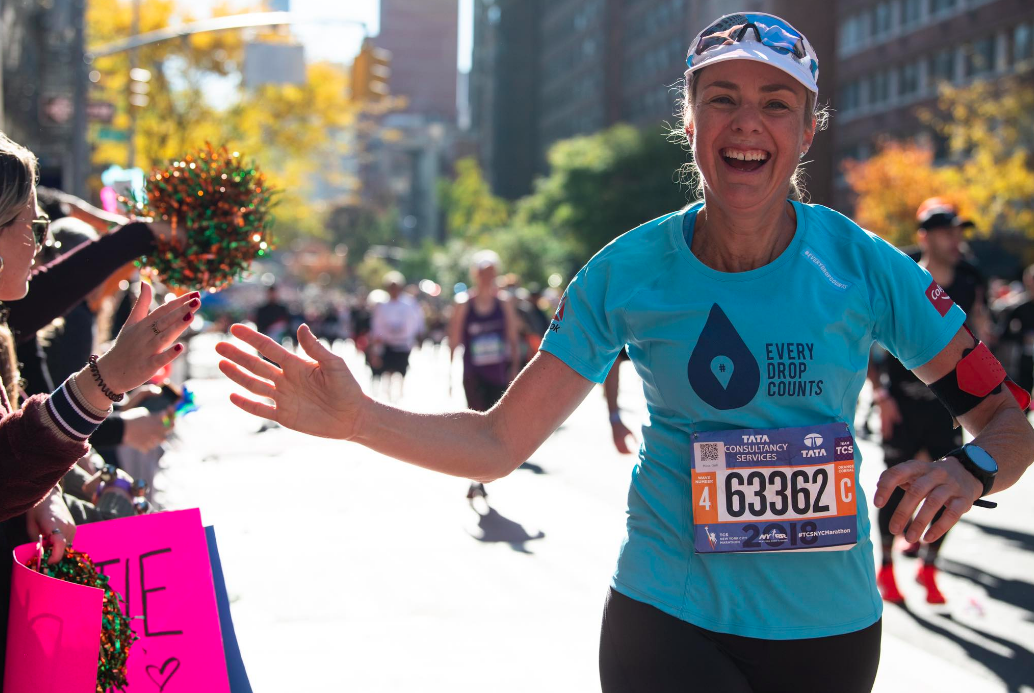
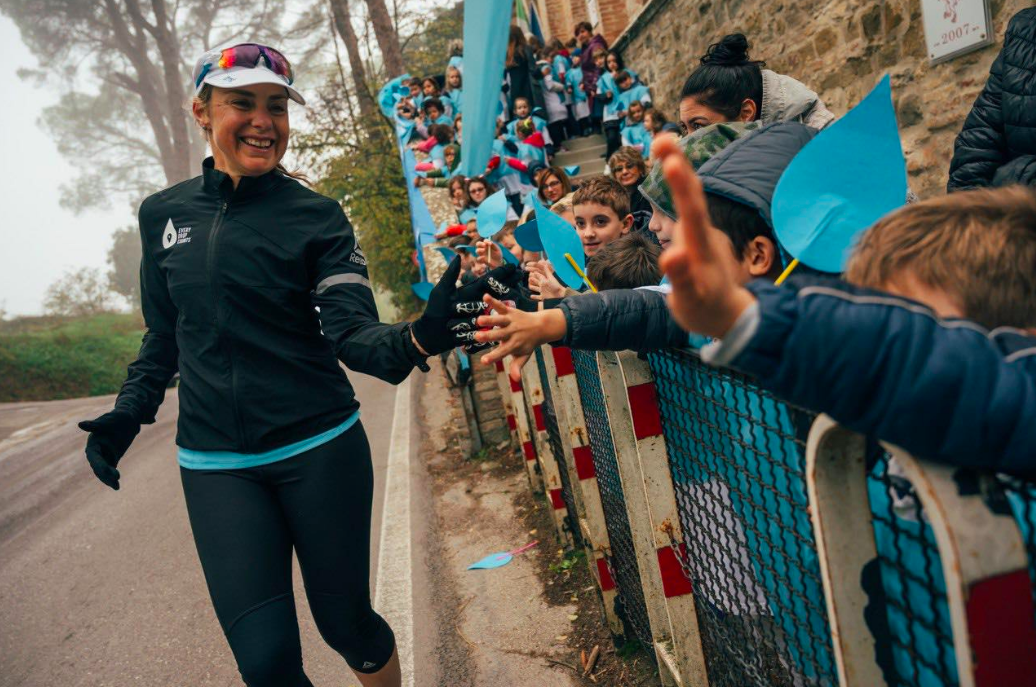
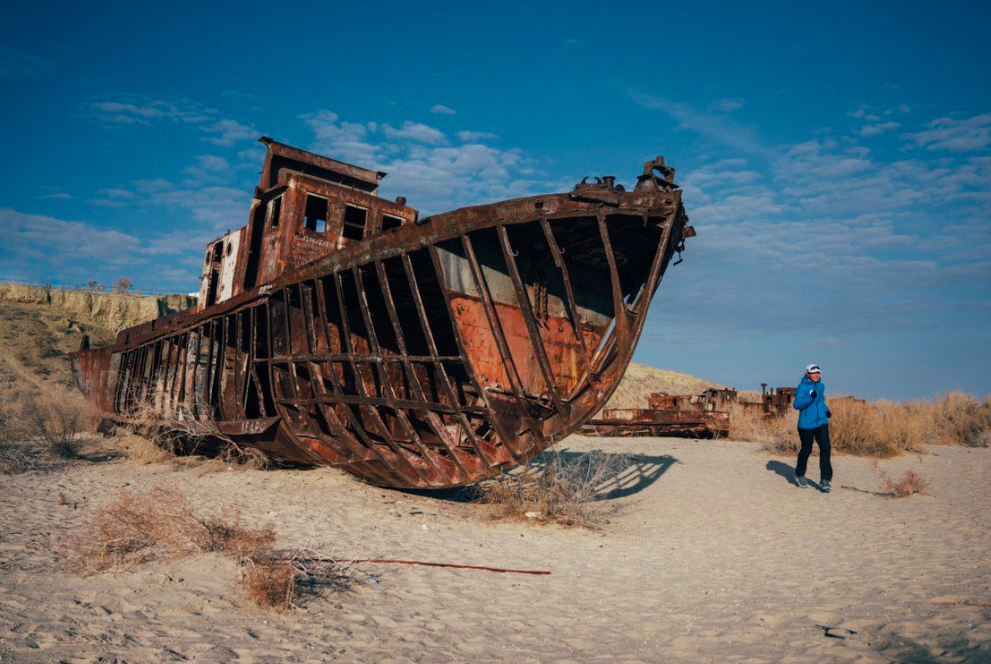
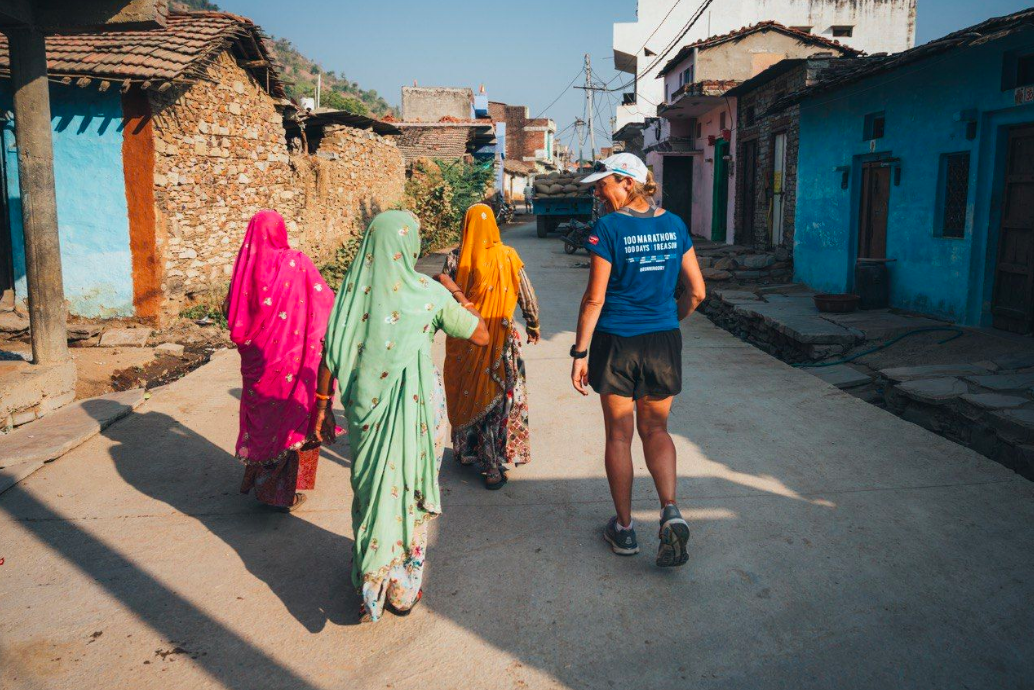
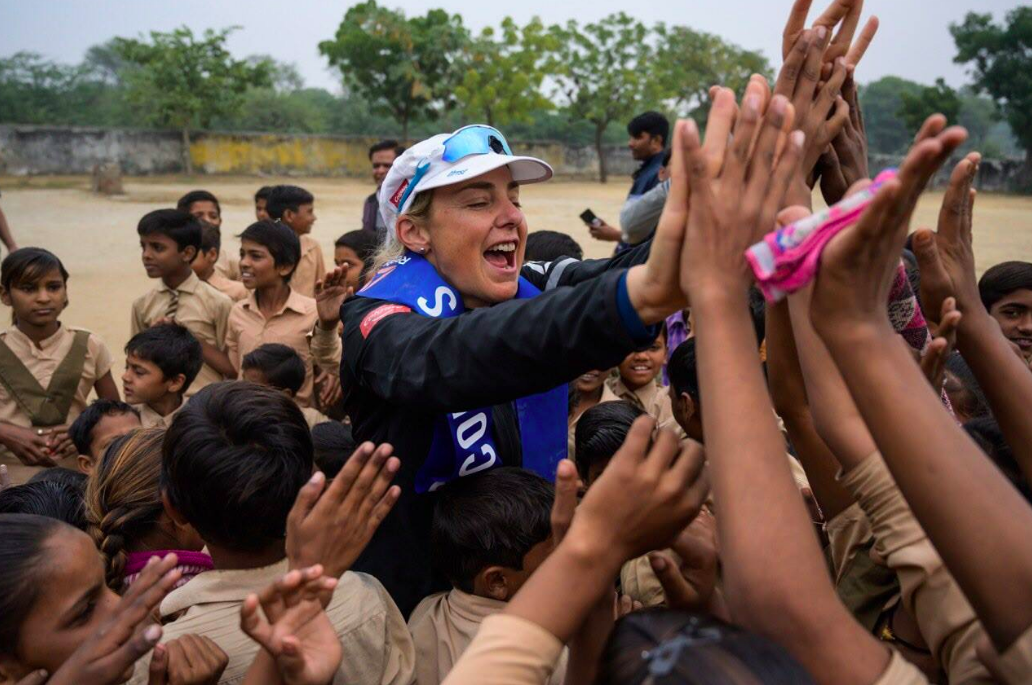

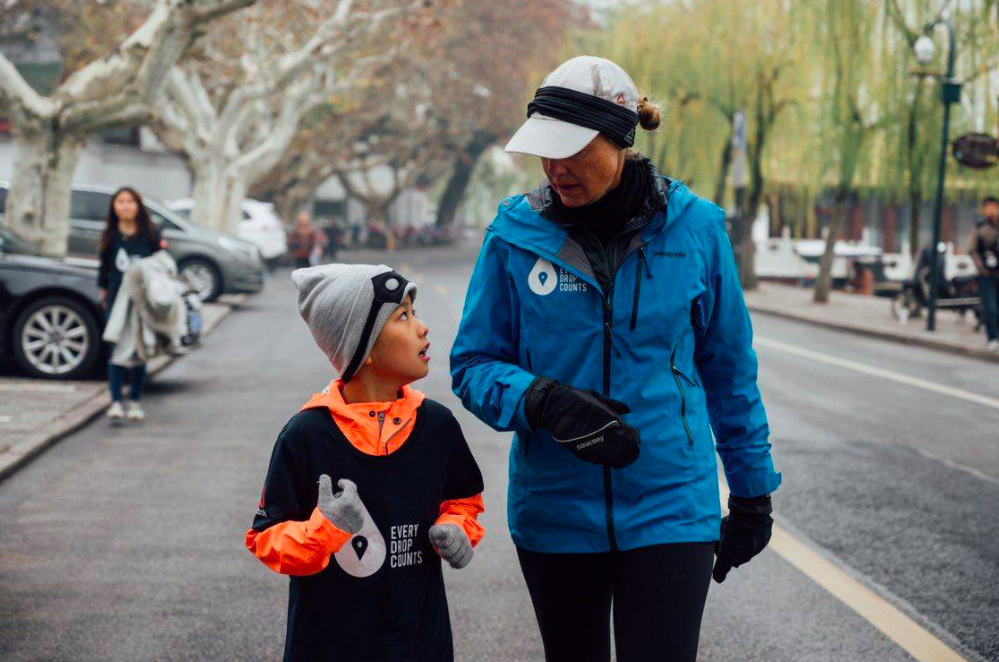
Photos: Kelvin Trautman
A team of storymakers
To sustain interest and build momentum over 100 days, it was really important to develop a content plan with built-in surprises, highlights and spectacular images. From Treeshake, we had Dave Duarte as Campaign Director; Bridget McNulty as Creative Director; Jaidan Rumboll as Community Manager; and Kelly Burke as Global PR lead.
Mina would be travelling with photographer Kelvin Trautman and videographer Jared Paisley. So, the first task was to find places for Mina to run that told the story, and would look good on camera. We also identified “water heroes” for her to meet along the way, and created infographics with key facts and tips about invisible water - the huge amount of water that goes into producing our food and clothing without us even being aware of it.
The Water Heroes turned out to be a key driver of the success of the campaign. We identified the most influential people in water in each of the locations Mina was due to run, and decided to celebrate one water hero every day with a blog post and tweet. This was a lot of work, but was one of the hidden drivers of the success of the campaign. The water heroes gave us insider info, and many also became active supporters on social media.
Production is one thing, gaining attention is another. A campaign on this scale needs teams with local media contacts. Four international PR consultancies were hired to support the campaign - Fenton in the US; Fleishman Hillard in China; Frank PR in Australia; and Bubble Communications in India. These agencies gave us access to local media and helped us navigate the cultural nuances of international PR and media, which tends to differ regionally.
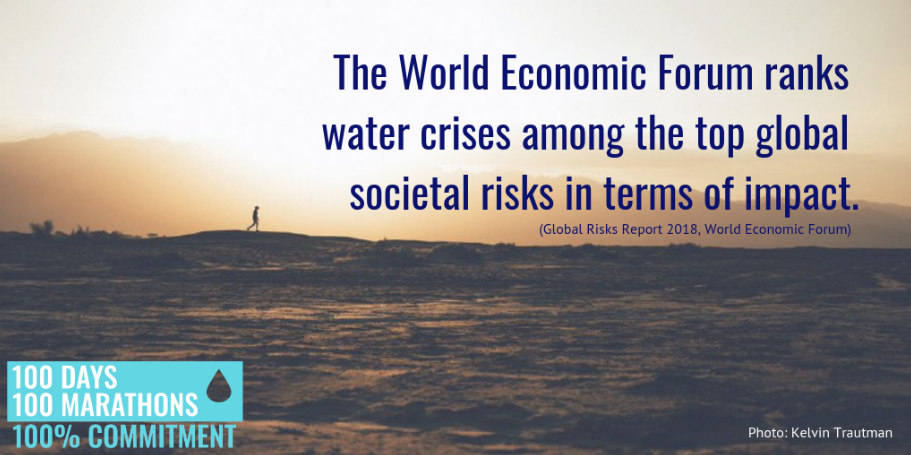
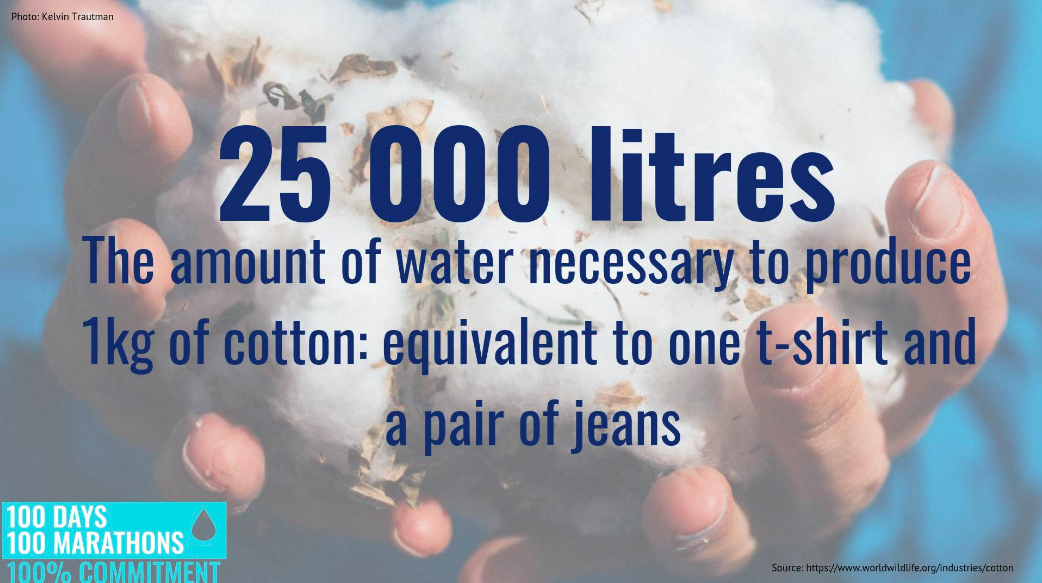
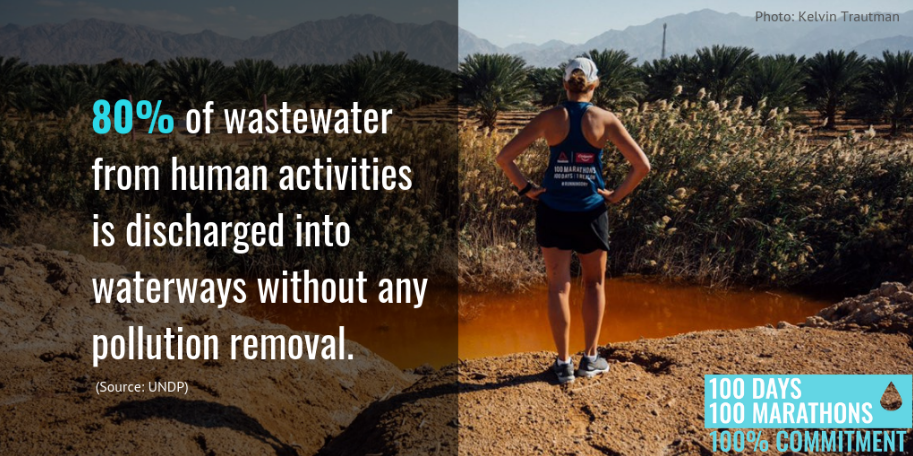
100 day logistics
The ground team travelled far, and fast, with Mina running a marathon every single day. Starting at the New York City Marathon on 4th November 2018, the team went across Europe (UK, France, Italy), Uzbekistan, India, China, Hong Kong, Dubai, the Middle East (Jordan, Palestine, Israel), South Africa, and Australia before crossing over to the USA and finishing the 100-day journey back where they started in New York on the 11th of February 2019. What this meant, logistically, is that often Mina would fly to a new country overnight, do media on arrival, drive a few hours to meet a water hero, and then run. A whole marathon. The schedule alone was a feat of endurance.
This would not have been possible without our brilliant and accomplished Chief of Staff, Melanie Ho who handled ALL the logistics - a daunting task considering the amount of travel, equipment, permits and more that needed to be arranged.
This kind of travel is not cheap, but was made possible by headline sponsors Reebok and Colgate. It was important to position the campaign and the sponsorship arrangement in a way that both benefited the sponsors and added to the campaign narrative. This was, and is, key to Mina’s campaigning model. To quote a New York Times piece about the campaign.
“Guli, 48, is part of a class of runners now picking up sponsorships the same way top-level runners coming out of college do. They won’t be winning the Boston Marathon or Olympic medals, but they offer something that shoe brands want to be a part of at a time when the top of the podium isn’t the only spotlight… Reebok and other companies are going after unique narratives they hope will inspire people.
Video: Jared Paisley
Consistently high social engagement
It was a gruelling pace, but right from the start the stories we were able to tell - on Facebook, Instagram, Twitter and Mina’s blog were beautiful, and heartbreaking. The global water crisis was being shown in true human form, and we were getting respectable numbers of video views organically. With attention to detail in ensuring that each community member felt appreciated and heard, social media engagement rates rose and were consistently higher than the norm. For example:
Facebook: 2.3% (Average Facebook engagement rate: 0.5%-1%)
Instagram: 7.9% (Average Instagram engagement rate: 2%)
Twitter: 1.7%. (Average Twitter engagement rate: 0.9%-1%)
With engagement growing, our focus on narrative, influencer partnerships, and community engagement was really paying off. By this stage Mina’s accounts had grown from around 10 000 followers to around 50 000 followers in the space of two months, we’d had respectable media coverage online, on radio, TV, and print. By all accounts it was going excellently.
An unexpected twist
Around marathon 50 Mina began walking her marathons, and they were taking more than 12 hours a day to complete. We decided to cancel her Ethiopian runs, as the relentless travel was also taking a toll. She came to South Africa and took an MRI, which verified what the whole team had feared: Mina had multiple stress fractures in her femur. Mina revealed this to the #RunningDry community in an honest video and series of photographs that many supporters said was a refreshing break from the airbrushed perfection of social media. She spoke to them person to person, sharing her vulnerability and despair at being injured.
While this was unfolding, Beaufort West, a town in the Western Cape of South Africa, literally ran dry. As terrible as this was, it was an opportunity to show the world what we were saying. Limping along, Mina joined local disaster relief organisation Gift of the Givers on the ground to donate water to the residents. It was a heartbreaking and powerful few days, and we told the story far and wide on local and international media. And then, Mina couldn’t go on.
Mina ran 62 marathons in 62 days, but on day 63 she was told by doctors that if she ran any more she would never run again. In fact, the fractures had grown since the time of her first MRI - she ran so hard she broke her leg.
As devastated as she was, we knew this was story gold. And so we kept asking the question “How does this make things better?” - an important question to consider in almost any crisis.
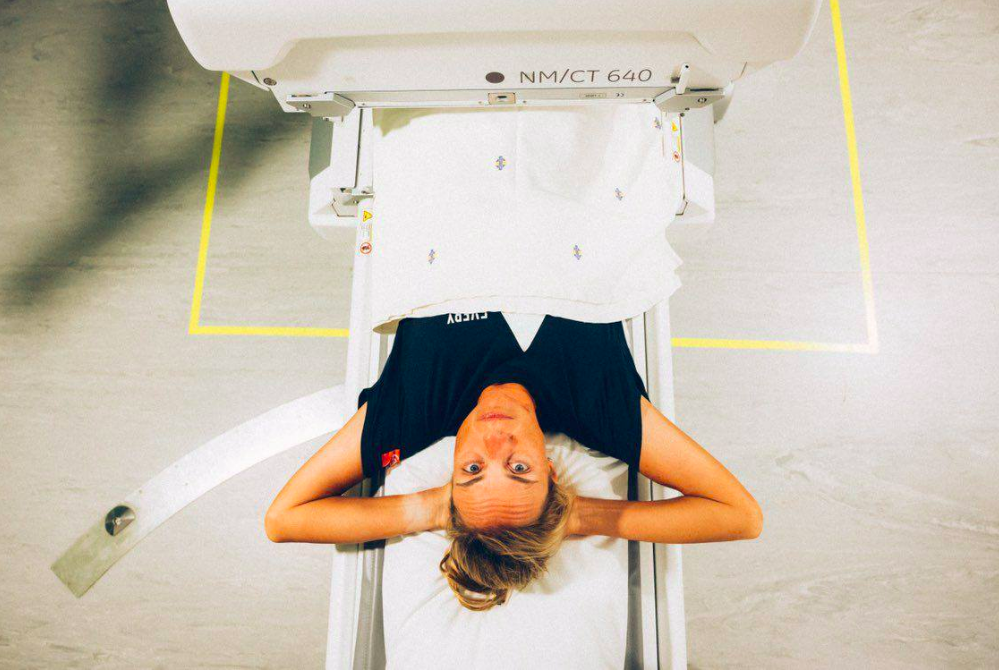

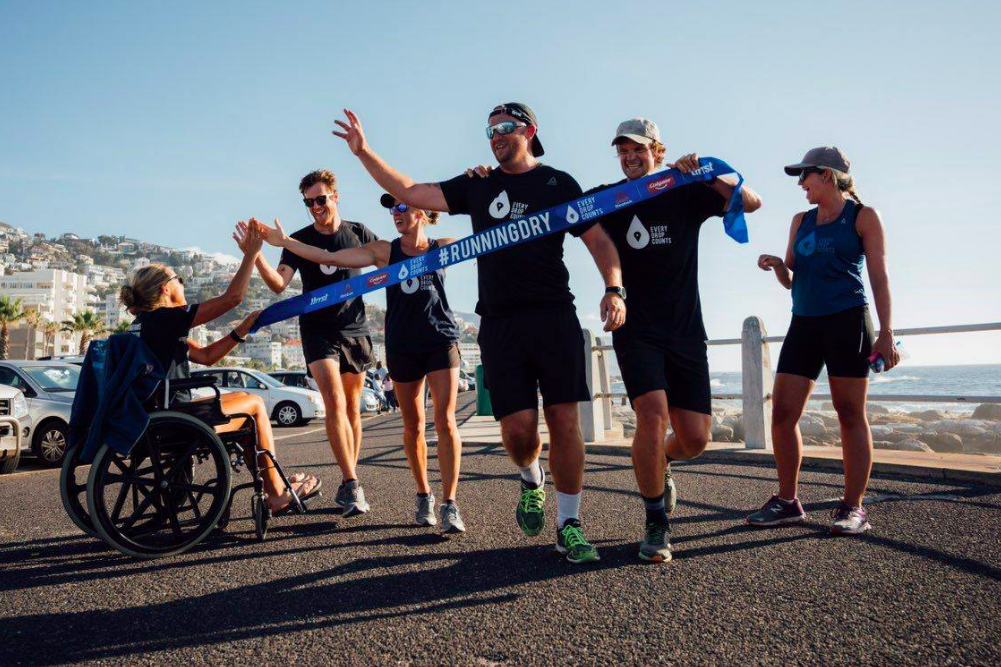

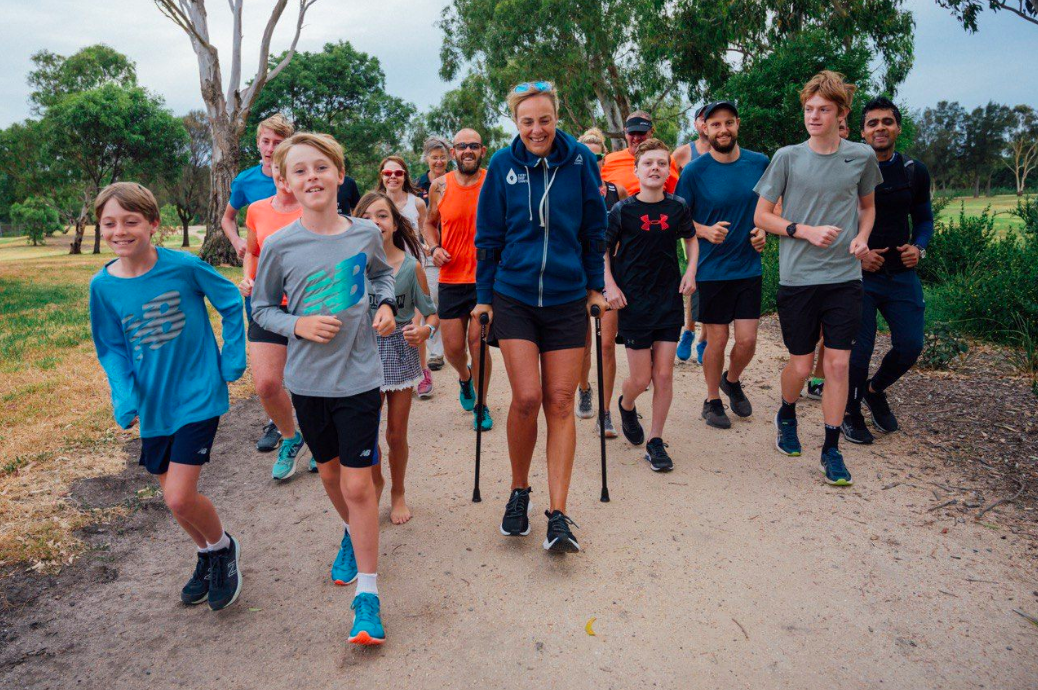
Photos: Kelvin Trautman
Campaign to movement
A few of Mina’s supporters had commented on her injury video, saying they wished they could run a marathon for her. We took this community led idea as our strategic cue, and realised this was how we would turn crisis into opportunity.
This was the point in the hero’s journey where the mentor would be needed to guide the hero through the transition. Lewis Pugh has played this role for both Treeshake and Mina and we asked him for his advice and support to help us all through this transition in the campaign and the story. He met Mina at the hospital and advised her that it was time to let others pick up the baton.
Starting off with a team run, we introduced the idea of Mina’s supporters completing her daily marathon for her. There was a lot of discussion about the dynamics of how we’d track success, and it was decided ultimately that we wouldn’t ask people to run full marathons but rather tally up ALL contributions - whether 1km or 100kms in a day.
The first follower was Bruno Sanchez from Madrid, who ran a full marathon for Mina as soon as the request was put out. That same day, we mobilized supporters in Cape Town, where Mina was that day, to contribute kilometres to the cause. The images and story were picked up by the Associated Press worldwide, and from there the #RunningDry movement began
A real community
Our team worked hard to make sure every single person who contributed distance to #RunningDry felt validated, and noticed. We replied to every comment, reached out on DM to thank people, and shone a spotlight on the community who was not only doing Mina’s distance for her, but also sharing water facts and helpful tips along the way.
To incentivise and acknowledge the community we also provided a daily tally of miles, posted on Twitter, which listed every person who contributed and ranked their distance. This proved to be a key motivator for people who contributed, as they knew that every extra mile they put in was being counted and made a difference in showing the scale of our movement.
Even though we’d only set out to log one marathon a day, hundreds of people were contributing runs that far exceeded this target. It was then that the next dream was born: Mina had set out to run 100 marathons in 100 days for water, what if the #RunningDry community ran 100 marathons in 1 day to show the power of collective action?
100 marathons in 1 day
We started working on the idea - reaching out by Direct Message to anyone who had contributed miles and asking for their support in the challenge, creating a special page on Mina’s website explaining exactly what to do, adding a pop-up so that anyone who visited the site would know about the marathon attempt. We set up a folder of easily shareable infographics on Facebook and punting the water saving messages we wanted to promote, and to let people know that we could only achieve this if we all worked together. On Sunday 27th January 2019, we attempted 100 marathons in 1 day, and we were blown away.
Mina’s vision for the 100 marathons in 100 days #RunningDry campaign was simple: to make saving water famous. Just over 2 weeks after announcing her injury on social media, the vision became a reality with #RunningDry becoming a worldwide movement.
As of midnight on the 27th of January, 251 marathons had been logged: an incredible distance of 10,629.3km. People donated kilometres from 44 different countries and territories - from Antarctica to Sweden, Mexico to Japan, Australia to Serbia and everywhere in between. Supporters logged distances from 1km to over 50km, in temperatures from -15°C to over 40°C, in deserts, snow and in forests. People ran by rivers and others by oceans and waterways. Some ran in cities and on tracks. Some ran in groups and others on their own. But every single one of them donated their miles on Sunday to support #RunningDry and help drive global water awareness.
Results
The reach of this campaign has been phenomenal. Press releases were picked up by the Associated Press multiple times and pushed to print, TV and radio around the world. The total online audience, according to Critical Mention, is 1,590,084,059 and growing daily. The estimated media value is currently sitting at over $100 million.
The rapid growth of the community online has been equally gratifying. Mina’s social media pages gained 232,506 new followers and fans throughout the campaign - with 24,830 new followers in just one week building up to the #RunningDry “100 marathons in one day” activation we did in late January.
There was an outpouring of positive comments and water facts shared, with users around the world taking to social media to share why they were running for water.
Finally, in April 2019 the United Nations selected the campaign as a top 3 finalist in their annual SDG Action Awards.
This documentary produced by ABC about Mina and the campaign tells the whole story and is well worth watching:
PARTS: The 5 working parts of company culture
Every good leader knows the importance of Company Culture, and yet it is difficult to grasp and actively shape. Culture determines a groups capability to respond to change, and to function as more than the sum of its parts. To help get a handle on this seemingly intangible concept let us introduce you to the PARTS of culture.
By Dave Duarte
Culture is the hidden force that shapes our decision-making day to day, what we value, and how we get things done. And yet culture isn’t something that can be set in place, it is emergent and adapts.
The PARTS of Culture provides an memorable framework to work with when aiming to influence culture. It stands for People, Artefacts, Rituals, Tools, and Stories.
A bit of background
When we launched the OgilvyDMA in 2010, Rob Hill and Gavin Levinsohn said our primary objective was to help "geekify" the Ogilvy Cape Town culture. Now, "Changing Culture" sounds all well and good, but when it came to it I had no idea where to start. I turned to sociological theory on culture for clarity, and out of that developed PARTS as a way to make the key concepts memorable and strategically actionable.
Here’s more details on each of these aspects, and how we applied them with remarkable success at Ogilvy.
People: gain the support of a few well connected people, and help them recruit others
Too many companies make the mistake of trying to change the whole company at once. You’re more likely to gain traction incubating culture among a group of influential people who have provide reach and access to the rest of the organisation.
Behaviours spread from person to person (Christakis, 2007). So it's important to work with a small group of people initially to make sure the cultural change is understood and adapted.
The key players in a social network are your Experts, Influencers, Gatekeepers, and Connectors. Each are important in their own ways, and you need to gain their support for any culture change initiative. These people need to have a high frequency of contact with the cultural change process an practice. They are going to be the ones that set the example and distribute the culture to the rest of the organisation. As Derek Sivers famously put it "new followers don't follow the leader, they follow the other followers."
At Ogilvy, the most influential people throughout the agency were invited to our first Ogilvy Digital Marketing Academy, and no expense was spared in ensuring a transformative learning experience that created group buy-in and connection.
Artefacts: make the culture change public and visible
Our physical environment and the objects in it form the stage on which your staff perform. Are you setting them up for great performances, giving them the cues and props they need? Art, Awards, and artefacts of belonging (like lapel pins, t-shirts, certificates) all serve to communicate cultural values.
Open Knowledge Foundation, "OPEN" lapel pin, by Brian Glanz
Amazon, for example, reminds people of their value of frugality through the use of door-desks throughout the company.
Ogilvy encouraged more a more digitally savvy culture by making the latest gadgets available to staff through Ogilvy Labs. There are screens live-streaming social data from clients, there are interactive demos of the latest in sensory technology around the office, and there are framed certificates displayed for people who complete digital training. Other artefacts could include the kinds of awards that are valued, for example, displaying Cannes Lions, or Bookmark Awards.
Rituals: Go from a moment to a movement
The things a company does regularly become a signal of their culture. The rituals can be small or large, everything from how you on-board staff to how you handle daily meetings.
The key thing when you want to introduce a ritual is to do it consistently and repeatedly. It takes time for new behaviours to take root. Your company values aren’t just things that you just write down and forget about, they should be reflected in what behaviours you reward. In who you hire, promote and let go. These create behavioural norms that become embedded in your company culture.
For example, Ogilvy hosts a regular “How-To Friday” session where people who have done something extraordinary share how they did it. This signals the company’s long-term commitment to hands-on innovation.
Tools: give people the resources to create change
How do you equip your people to do their work in a way that reflects company culture? You can't expect change if you don't enable it. Language, skills, technology, equipment, and other resources are major enablers of change.
The most fundamental tool for culture-shaping is language. When you want to shift culture, equip people with new ways to talk about what they do.
A key part of the Ogilvy Digital Marketing Academy's success was, and is, giving people the language to speak about digital. Concepts like Impressions, Reach, Landing Pages, and Programmatic become more useful when we have the words to talk about them.
Story: don't just tell people about the change, show them what others are doing
Stories are the way that people naturally encode and share complex social information. There are two ways a company can bring their story to life: storytelling and storymaking.
Storytelling is about finding examples of good cultural practice and crafting stories around those actions so that it is easier for others to understand what to do, and to emulate the success of the cultural heroes you celebrate.
Storymaking is about kickstarting this process. It’s not just about what you celebrate, but also how you take action. It is about taking decisive action to establish cultural precedence.
At Ogilvy, stories were created by investing more heavily in case-studies involving digital integration, such as Be The Coach (which went on to become the most awarded campaign of the year - winning international plaudits including four Gold Lions at Cannes)
Stories are like software for the mind. They help us understand cause and effect, and can have a transformative effect on what we see as possible and expected.
The results of the first application of our PARTS model can best be summed up by Ogilvy Cape Town's Managing Director, Gavin Levinson
“What’s the best thing that’s happened in the Ogilvy ‘family’ over the past three years? While there are many highlights and accolades within and across all of Ogilvy’s companies, I would undoubtably say that the ODMA has and continues to be our finest hour.”
Treeshake offers story-making workshops and talks on culture change, leading innovation, and values-driven leadership.
If a story moves you, act on it
Stories are necessary, but they're not as magical as they seem, says writer Sisonke Msimang. In this funny and thoughtful talk, Msimang questions our emphasis on storytelling and spotlights the decline of facts. During a critical time when listening has been confused for action, Msimang asks us to switch off our phones, step away from our screens and step out into the real world to create a plan for justice.
Stories are necessary, but they're not as magical as they seem, says writer Sisonke Msimang. In this funny and thoughtful talk, Msimang questions our emphasis on storytelling and spotlights the decline of facts. During a critical time when listening has been confused for action, Msimang asks us to switch off our phones, step away from our screens and step out into the real world to create a plan for justice.
I'm here to talk about my own observations about storytelling. I want to talk to you about the power of stories, of course, but I also want to talk about their limitations, particularly for those of us who are interested in social justice.
Stories are everywhere, and if there was a danger in the telling of one tired old tale, then I think there has got to be lots to celebrate about the flourishing of so many stories and so many voices. Stories are the antidote to bias. In fact, today, if you are middle class and connected via the internet, you can download stories at the touch of a button or the swipe of a screen. You can listen to a podcast about what it's like to grow up Dalit in Kolkata. You can hear an indigenous man in Australia talk about the trials and triumphs of raising his children in dignity and in pride. Stories make us fall in love. They heal rifts and they bridge divides. Stories can even make it easier for us to talk about the deaths of people in our societies who don't matter, because they make us care. Right?
“If it is justice that we are after, then I think we mustn’t focus on the media or the storytellers. We must focus on audiences, on anyone who has ever turned on a radio or listened to a podcast, and that means all of us”
I'm not so sure, and I actually work for a place called the Centre for Stories. And my job is to help to tell stories that challenge mainstream narratives about what it means to be black or a Muslim or a refugee or any of those other categories that we talk about all the time. But I come to this work after a long history as a social justice activist, and so I'm really interested in the ways that people talk about nonfiction storytelling as though it's about more than entertainment, as though it's about being a catalyst for social action. It's not uncommon to hear people say that stories make the world a better place. Increasingly, though, I worry that even the most poignant stories, particularly the stories about people who no one seems to care about, can often get in the way of action towards social justice. Now, this is not because storytellers mean any harm. Quite the contrary. Storytellers are often do-gooders like me and, I suspect, yourselves. And the audiences of storytellers are often deeply compassionate and empathetic people. Still, good intentions can have unintended consequences, and so I want to propose that stories are not as magical as they seem.
So three -- because it's always got to be three -- three reasons why I think that stories don't necessarily make the world a better place.
Firstly,
stories can create an illusion of solidarity. There is nothing like that feel-good factor you get from listening to a fantastic story where you feel like you climbed that mountain, right, or that you befriended that death row inmate. But you didn't. You haven't done anything. Listening is an important but insufficient step towards social action.
Secondly,
I think often we are drawn towards characters and protagonists who are likable and human. And this makes sense, of course, right? Because if you like someone, then you care about them. But the inverse is also true. If you don't like someone, then you don't care about them. And if you don't care about them, you don't have to see yourself as having a moral obligation to think about the circumstances that shaped their lives.
Thirdly,
I think that stories don't necessarily make the world a better place because too often we are so invested in the personal narrative that we forget to look at the bigger picture. And so we applaud someone when they tell us about their feelings of shame, but we don't necessarily link that to oppression. We nod understandingly when someone says they felt small, but we don't link that to discrimination. The most important stories, especially for social justice, are those that do both, that are both personal and allow us to explore and understand the political.
Photo credit: recombiner
But it's not just about the stories we like versus the stories we choose to ignore.
Increasingly, we are living in a society where there are larger forces at play, where stories are actually for many people beginning to replace the news. We live in a time where we are witnessing the decline of facts, when emotions rule and analysis, it's kind of boring, right? Where we value what we feel more than what we actually know. A recent report by the Pew Center on trends in America indicates that only 10 percent of young adults under the age of 30 "place a lot of trust in the media." Now, this is significant. It means that storytellers are gaining trust at precisely the same moment that many in the media are losing the confidence in the public. This is not a good thing, because while stories are important and they help us to have insights in many ways, we need the media. From my years as a social justice activist, I know very well that we need credible facts from media institutions combined with the powerful voices of storytellers. That's what pushes the needle forward in terms of social justice.
In the final analysis, of course, it is justice that makes the world a better place, not stories. Right? And so if it is justice that we are after, then I think we mustn't focus on the media or on storytellers. We must focus on audiences, on anyone who has ever turned on a radio or listened to a podcast, and that means all of us.
So a few concluding thoughts on what audiences can do to make the world a better place:
- The world would be a better place, I think, if audiences were more curious and more skeptical and asked more questions about the social context that created those stories that they love so much.
- The world would be a better place if audiences recognized that storytelling is intellectual work. And I think it would be important for audiences to demand more buttons on their favorite websites, buttons for example that say, "If you liked this story, click here to support a cause your storyteller believes in." Or "click here to contribute to your storyteller's next big idea." Often, we are committed to the platforms, but not necessarily to the storytellers themselves.
- I think that audiences can make the world a better place by switching off their phones, by stepping away from their screens and stepping out into the real world beyond what feels safe.
Alice Walker has said, "Look closely at the present you are constructing. It should look like the future you are dreaming."
Storytellers can help us to dream, but it's up to all of us to have a plan for justice.
Sisonke Msimang tells stories about justice and human rights. In the early part of her career, Msimang set up a fund fight for people whose health had been compromised by their race, class and gender identities. In 2008 she became the executive director of the Open Society Initiative for Southern Africa, responsible for making grants on human rights projects. Msimang is now the head of programs at the Centre for Stories, a new initiative that collects, preserves and shares stories about migrants, refugees and diverse people and places linked to the Indian Ocean Rim.
This is an extract from a 2016 talk delivered by Sisonke Msimang entitled "If a story moves you, act on it" delivered at TEDWomen, published under a Creative Commons Attribution License
The longevity of stories
We need stories. To communicate, to understand, to relate to each other, to explain. People have, throughout time and history, incorporated storytelling (and storymaking) into their lives, because it's how we make sense of the dynamic, often complex, situations we find ourselves in. Neil Gaiman, a master storyteller, outlines the importance of a good story, and the ability stories have to shape culture and behaviour
We need stories. To communicate, to understand, to relate to each other, to explain. People have, throughout time and history, incorporated storytelling (and storymaking) into their lives, because it's how we make sense of the dynamic, often complex, situations we find ourselves in. Neil Gaiman, a master story teller, outlines the importance of a good story, and the ability stories have to shape culture and behaviour:
By Neil Gaiman
Stories aren’t books. Books are simply one of the many storage mechanisms in which stories can be kept and, obviously, people are one of the other storage mechanisms. Stories change. The professions, the media that we use to store, record and transmit stories will change. Not long ago the people who stored and transmitted information were stonemasons. Now, not so much. Unless we want the information to last.
As individuals, we are cut off from humanity. As individuals, we are naked, we do not even know which plants will kill us. Without the mass of human knowledge accumulated over millennia to buoy us up, we are in big trouble. With it, we are warm, fed, we have popcorn, we are sitting in comfortable seats and we are capable of arguing with each other about really stupid things on the internet. That's because we have stories, it's because we have information.
In 1984 a man, whose name I don't know how to pronounce, I think it's Thomas Sebeok, wrote a report for the Department of Energy. He was asked to create a report because they had a problem - what to do with nuclear waste repositories. They needed to devise a method of warning future generations not to mine or drill at that site unless they're aware of the other consequences of their actions… and because the stuff that they would be putting in these nuclear waste repositories had a half-life of 10000 years, they needed to figure out ways to get information to last 10000 years. They started by looking at all you can write. The trouble with writing things is that it lasts a certain amount of time, but anyone here who’s actually tried to read Beowulf in the original knows that that only takes you so far. Language changes. Words change meaning. And if language is changing, what about pictographics? What if you put a big skull up? And Thomas pointed out that even a skull means different things in different cultures - some cultures might go “ahh, skull, symbol of warning,” some might go, “symbol of fantastic candy days. This is the place where the good stuff!”.
ISO Radiation Warning Sign
What he actually came up with, he said that the prime recommendation of the Human Interference Task Force of Department of Energy was that information be launched and artificially passed down into the short-term and long-term future, with these supplementary aid of folkloristic devices, in particular a combination of artificially created and nurtured ritual and legend. The most positive aspect of such a procedure is it need not be geographically localised, or tied to any one language or culture. So, the initiated would be steered away from the hazardous site, for reasons other than the scientific knowledge of the possibility of radiation and its implications, essentially the reason would be accumulated superstition to shun a certain area permanently.
A ritual with the legend retold year by year, with presumably slight variation. The actual “truth” would be entrusted exclusively to, what we might call for dramatic emphasis, an ‘atomic priesthood’ - it is a commission of knowledgeable physicists, experts in radiation sickness, anthropologists and whatever additional expertise may be called for in the future. Folklore specialists that they’d consulted say they know of no precedent, nor could they think of a parallel situation, except the well-known but ineffectual curse is associated with the burial sites of some Egyptian Pharaohs, which didn't deter greedy grave robbers from digging for hidden treasure.
“What we can do, I think, is try and create stories that are interesting enough and important enough that our grandchildren might want to tell those stories to their grandchildren. Because that’s the purpose of stories. It’s what they’re for. ”
First Emperor of China, Qin Shi Huang
Terracotta Warrior
Which is true, up to a point. The first emperor of China died 2000 years ago, and the site of his tomb was lost. Very intentionally lost - he killed anybody who knew where it was. It was a magnificent act of tomb losing. And then one day, in a field in China, somebody unearthed a Terracotta Warrior. And then they found another one. They excavated warriors and archaeologists worked out very quickly where the actual mausoleum had to be. The stories that come down to us 2300 years after the emperor China at died, now became a warning. Remember those lakes of mercury? That stuff is really poisonous. It doesn't even have a half-life, it's just there. As Terry Pratchett once said, “Radiation is 10000 years, arsenic is forever,” and so they didn't immediately start digging, instead they checked, confirmed the presence of incredibly high quantities of mercury and have been figuring out what to do ever since. And when they figure out how to get in there without dying, they will start excavating.
The Long Now, and the clock of The Long Now is about planning for the long term, and thinking in the long term, in a world in which people appear to be thinking in the shorter and shorter term, not even necessarily at this point about things that will take them to the end of their lifetime, which at least at one point you would have thought, “well, you know, I'll be dead before that's a problem,” looking around now, the mess we’re making of things on his planet. You wanna go to people and say, “you know actually, you will be. You will still be around. We could run out of water, you'll be here, having to figure out what to do with no water. What to do when the oceans are screwed up. What to do when Twitter finally becomes sentient.
Tom Sebeok concluded that you couldn’t actually create a story that would last 10000 years, you could only create a story that would last a 3 Generations - for ourselves, for our children, for their children. But what we can do, I think, is try and create stories that are interesting enough and important enough that our grandchildren might want to tell those stories to their grandchildren. Because that's the purpose of stories. It's what they’re for. They make life worth living and, sometimes, they keep us alive
Neil Gaiman has told stories in every medium—graphic novels (The Sandman), novels (The Ocean at the End of the Lane; American Gods), short stories (Trigger Warning), children’s books (The Graveyard Book), television (Dr Who), and the occasional song (“I Google You”)
This is an extract from a 2015 talk delivered by Neil Gaiman entitled "How Stories Last" delivered for the Long Now Foundation, published under a Creative Commons Attribution License
A tangible demonstration of the power of storytelling: The significant objects experiment
The Significant Objects experiment is a tangible demonstration of the power of storytelling in sales and marketing. Journalist Rob Walker purchased low value objects, for on average $1.25 and had great creative writers invent stories about them. He then posted the articles on e-Bay to see if the invented story enhanced the value of the object based on what price it achieves on auction.
It did.
The Significant Objects experiment is a tangible demonstration of the power of storytelling in sales and marketing.
Journalist Rob Walker purchased low value objects, for on average $1.25 and had great creative writers invent stories about them. He then posted the articles on e-Bay to see if the invented story enhanced the value of the object based on what price it achieves on auction.
It did.
An old pepper shaker was bought for 99 cents, and sold for $28.00. A butterfly embossed cigarette case was bought for 10 cents, and sold for $33.77. A horse bust was bought for 99c and sold for $62.95
All in all, 100 pieces were cost $128.74, and were sold for $3612.51 - a whopping 2780% increase in value.
That's story power.
This apple was bought for $1.00, and sold for $102.50 with a story.
What "The Father of Modern Advertising" Can Teach Us About the Future of the Ad Agency Business
With so much changing about the advertising business, it is sometimes useful to go back to the origin of the industry to discover what has remained through all the changes With so much changing about the advertising business, it is useful to go back to the origin of the industry to discover what has remained through all the changes to discover the timeless value proposition of the industry.
With so much changing about the advertising business, it is useful to go back to the origin of the industry to discover what has remained through all the changes.
The most recent "Under the Influence" podcast featured Albert Lasker, "The most interesting adman in the world" (and early leader of what was to become FCB).
I loved this anecdote:
One day [Albert Lasker] was sitting in his offices, and a secretary handed him a note that said:
"I am downstairs in the saloon. I can tell you what advertising is. I know you don't know. If you wish to know what advertising is, send the word 'Yes' down with the bellboy. Signed – John E. Kennedy."
Lasker was intrigued and sent the word 'Yes' down to the saloon.
Kennedy was shown into Lasker's office.
He was a strapping 6-foot tall, ex-Mountie who used to write ads for the Hudson's Bay Company.
When Kennedy asked Lasker if he knew what advertising was, Lasker said, "I think so. It's news." [news is perhaps what we'd call storytelling]
Kennedy said no, news was just a technique.
The secret to advertising, Kennedy said, can be summed up in just three words:
"Salesmanship in print."
Those three words would change the advertising world forever…
"Salesmanship in print" was an epiphany to the advertising world in 1904.
What's today's equivalent of "salesmanship in print"? Perhaps considering the proliferation of channels we could call it "mediated salesmanship".
What is the timeless value proposition of the ad agency business?
Lasker's most successful campaigns seem to have something in common: a fresh perspective on an existing product, based on a consumer insight. For example:
- from selling oranges to linking "Drink an Orange" to the breakfast ritual
- from puffed wheat to "cereal shot from a gun"
- from birth control to "Planned Parenthood"
- Kleenex napkin (for wiping off make-up) to a "Disposable handkerchief"
This isn't storytelling per se, it is more about a creative perspective on the product. What we do is give consumers a different story about a product. And this enhances their experience of the product. This is perhaps a shift from story-telling (you tell the story), to story-making - where you offer a perspective, or do something, that gives people a new story to attach to a product or experience.
This is pretty much what advertising agencies still do. So what else hasn't changed?
- Results: no matter what, clients want results, usually sales.
- Persuasion: it needs to change behavior in some way. It needs to be convincing.
- Emotion: drives action & memorability
- Attention: clients want to be noticed.
- Relevance: the work must be relatable and relevant to the target audience
- Insight: great work is always based on an insight into human psychology of the target
- Efficiency: clients will always want to pay less for more, and faster
- Recognition: clients will always want their brand to be more recognised
- Timing: when people see the ad, and the timing of the campaign in relation to whatever else is happening in the world is always going to be important.
If we innovate in service of these values, we will thrive. Marketing today still requires creative perspectives and brilliant copywriting, but is also informed by user experience design, behavioral economics, smart targeting (e.g. Google Adwords and Programmatic), and machine learning (smart recommendations and adaptive offers).
What are the other timeless truths of advertising or your aspect of the business (whether production, or print, or traffic, or strategy...). Our world is changing fast! The practices change, the principles remain.





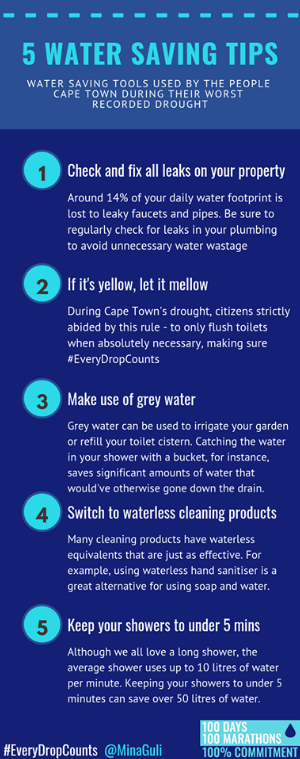
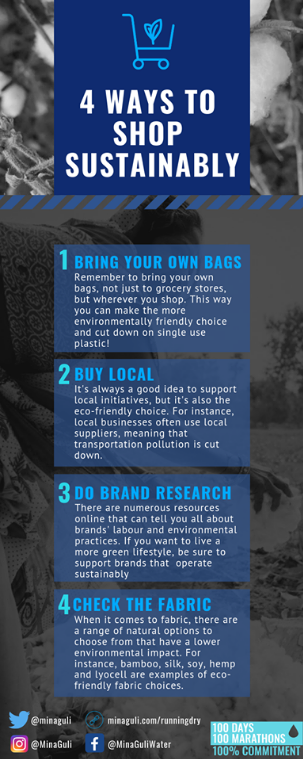
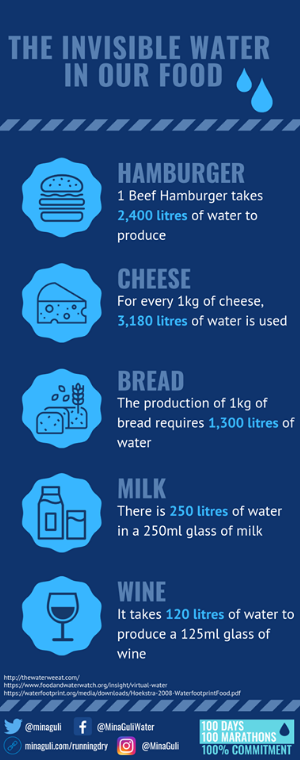



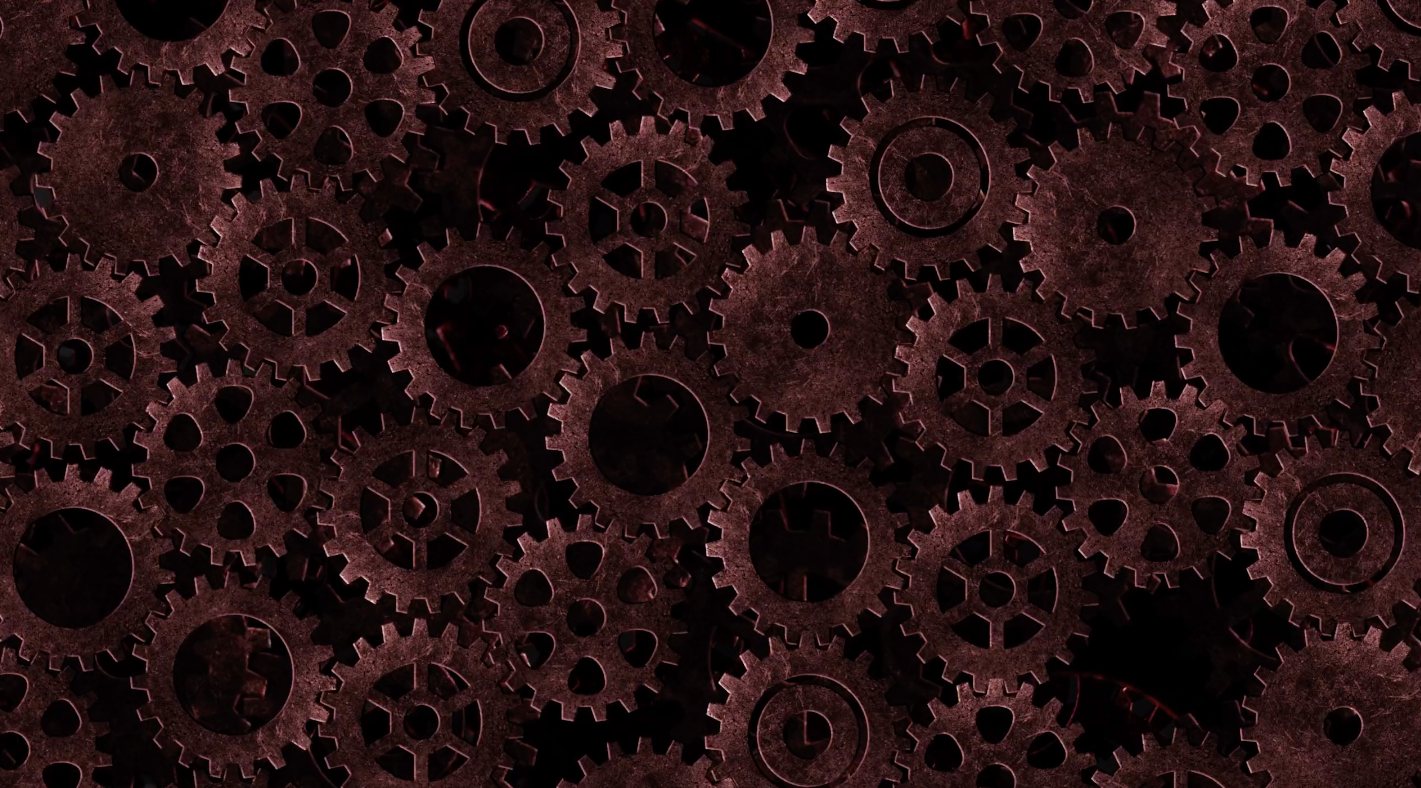
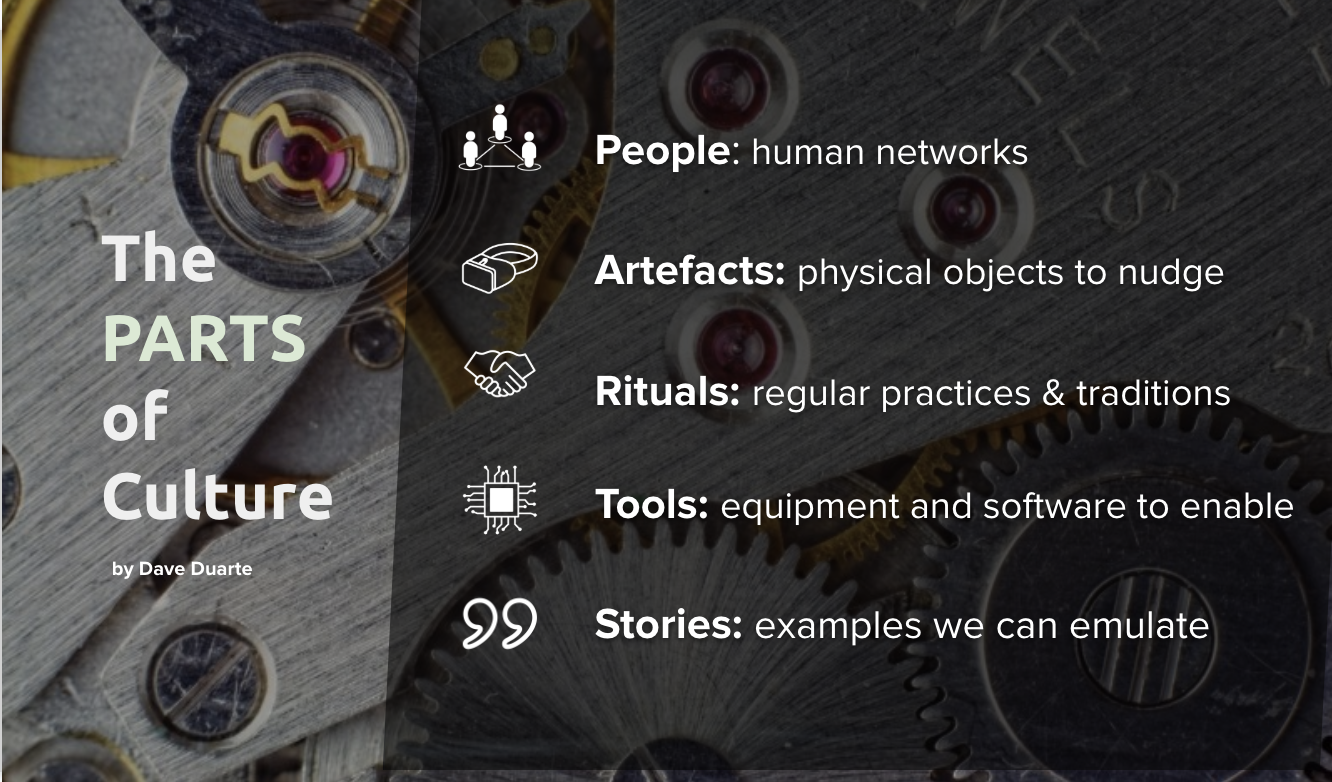
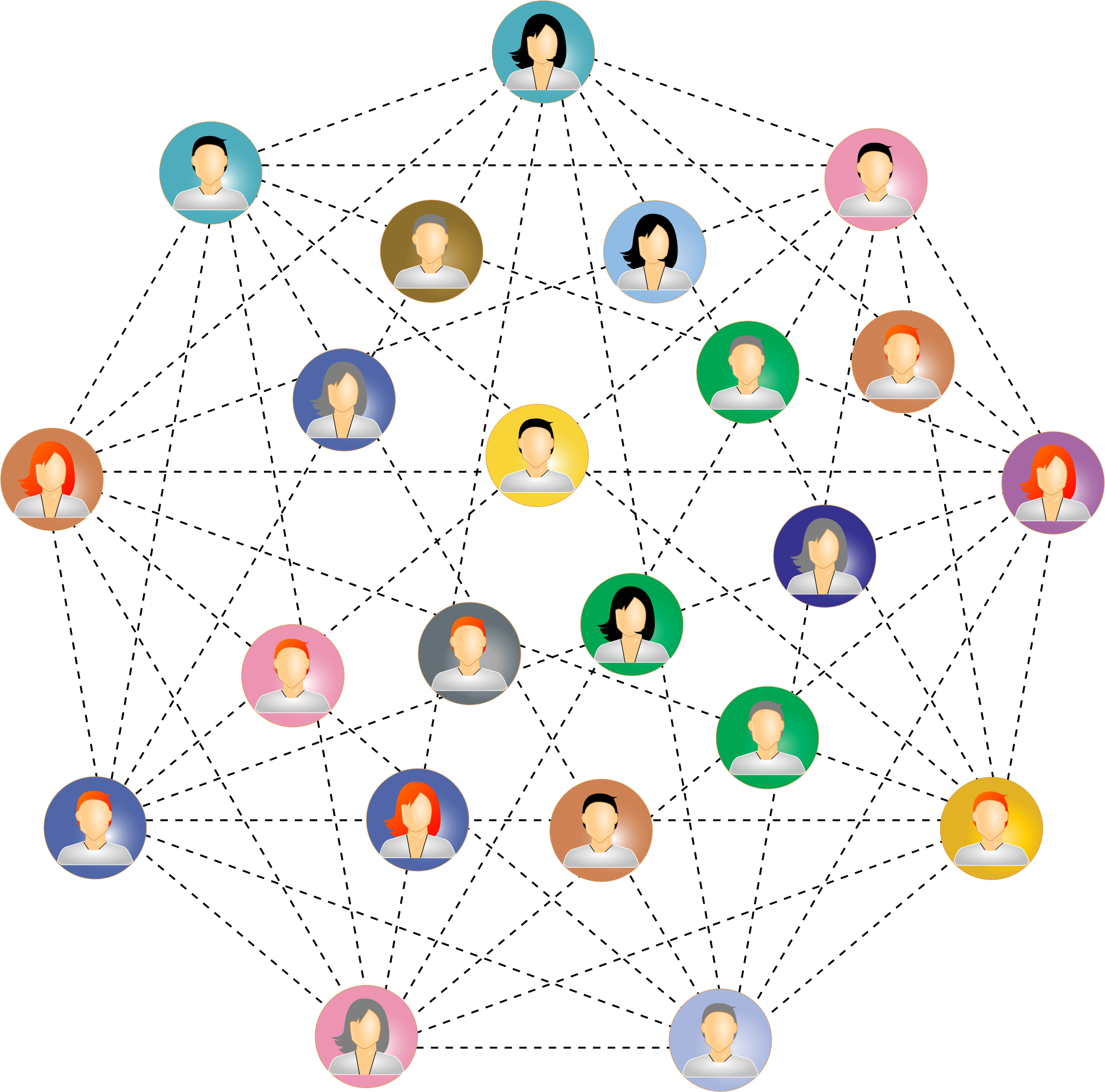








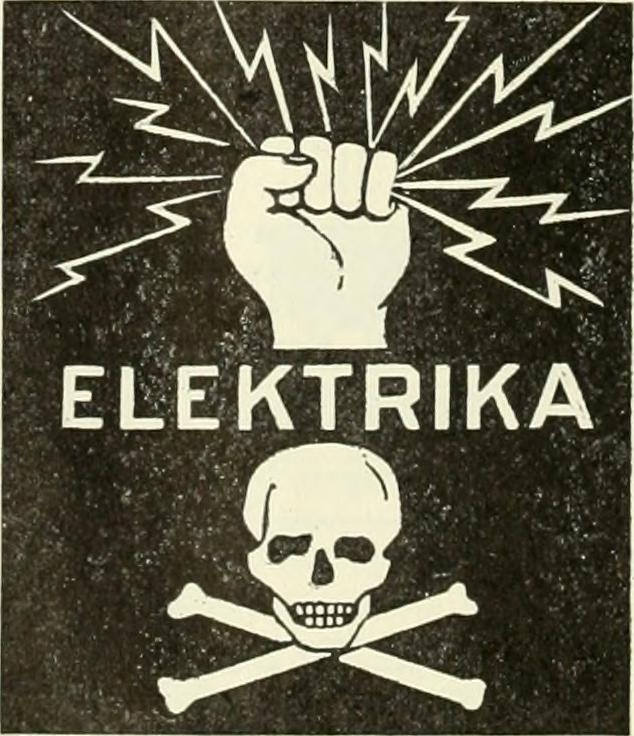













Dave Duarte, founder of Treeshake, is passionate about community engagement as a driver of value. As social marketer, speaker, facilitator and advisor, his warm and engaging style makes the future easy to engage with. Dave brings over a decade of facilitation experience to his work at Treeshake. He has founded several businesses, and served in leadership positions in media, academia, and non-profits.